Around Homer
Mt. Redoubt said hello to us as we drove down the Sterling Highway. We left it behind us and curved around the southwestern bulge of the Kenai Peninsula toward Homer.
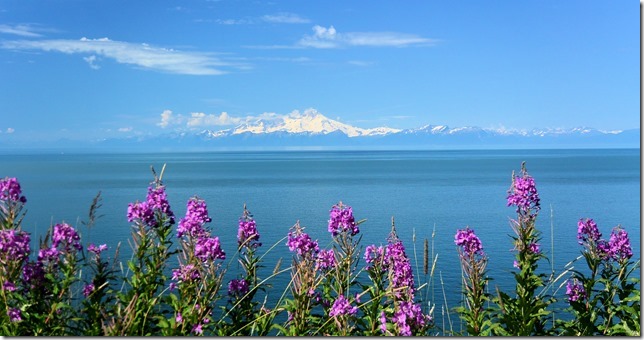
Homer is on my favorites list. And that can be a little puzzling. There’s not a great deal of wildlife to be seen, because Homer and the surrounding area are fairly well populated. The scenery is pleasant, but not striking. But there is a richness here, a texture of greens and blues and sea and sky, that swells my spirit and simply makes me glad to be here.
I also think that a deep and abiding charm of Homer is the Spit. When the Kachemak Bay glacier receded at the end of the Ice Age, it left a “terminal moraine”, a massive ridge of rubble that had been pushed up by the toe of the glacier. That long line of rubble, appropriately enhanced by decades of shovels and bulldozers, is now the Homer Spit.
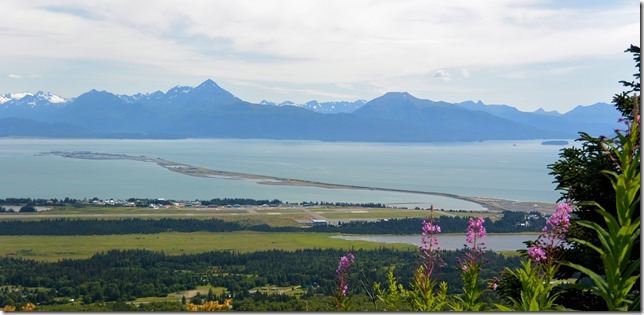
The first thing you notice about the Spit is that it sticks a long way out into the Kachemak Bay, giving you broad, sweeping vistas of the ocean and surrounding mountainous shorelines. Snow-capped peaks and glaciers line up on display, and the low elevation of the Spit gives you 360 degree views from almost anywhere you stop. It’s nice to feel surrounded by nature, AND be able to see so much of it.
The second thing about the Spit is that there are a LOT of camping areas on it, both shorelines, and these are some of the most pleasant camps we’ve experienced. They are universally crowded (not so nice), but that shoulder-to-shoulder feeling is more than offset by the expanse of the sea out our front windows. Camps range from $15 to $70, and since we need no electric or water, we take the cheap seats. Other than hookups, the camps are virtually identical: Gravel parking areas on the edge of the ocean.
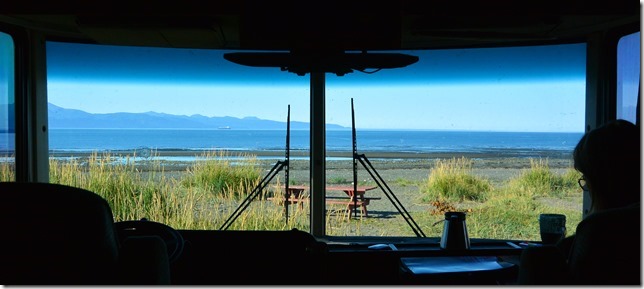
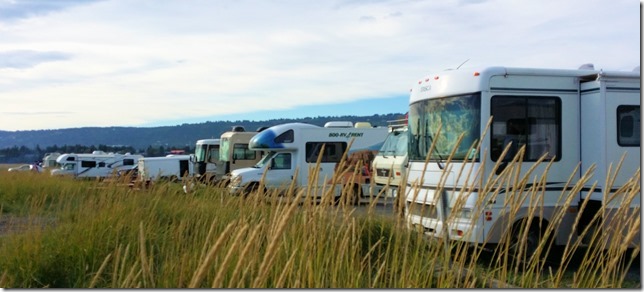
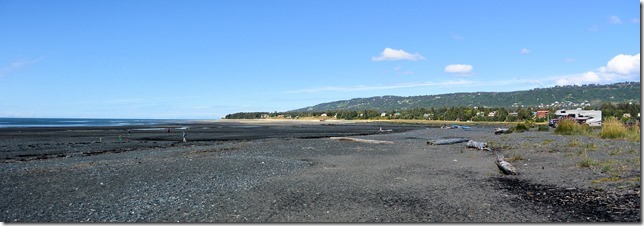
Like much of the Kenai Peninsula, Homer experiences some of the world’s largest tide swings. This is due to the shape of the peninsula and the depth of the bays. While we were at Homer, we saw 25-foot tidal changes. Coupled with the flat beaches, the tides make for enormous tidal flats at low tide. We would see the water nearly at our doorstep at noon, only to find it almost a quarter-mile away in the evening. Remarkable. Here’s a gal out for a trot at low tide; not even her helmet would be above the high-water level, and she’s still high on the beach.
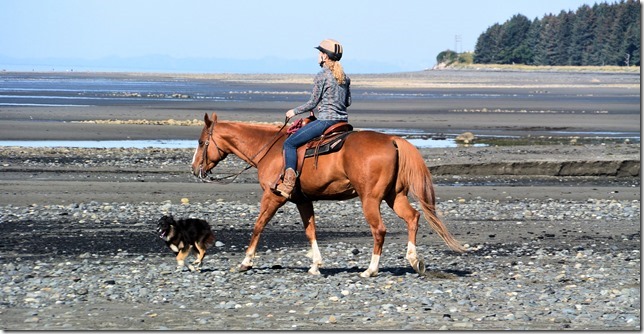
Wind-surfers love it of course. The off-shore breeze made for really long runs, and very pleasant evening entertainment for us campers.
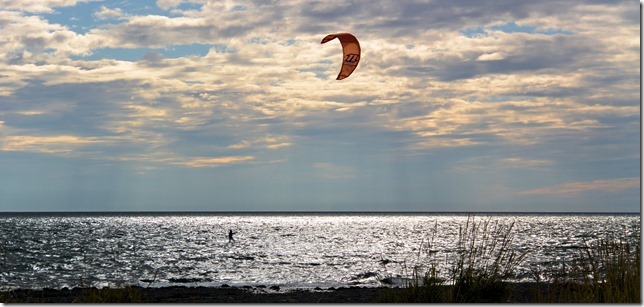
Side-trip: Seldovia One of the two towns across Kachemak Bay, Seldovia is a common tour destination. At our senior’s price of $53 it was a bargain, so off we went. The tour boat boasts “wildlife” as part of the deal, which in this case is sea life consisting largely of birds and otters. The weather was spectacular, blue skies and calm seas, and our first stop at a seagull rookery was up-close with these cliff-dwelling birds. The puffins were also still in residence, albeit reduced in population due to a recent bald-eagle scourge.
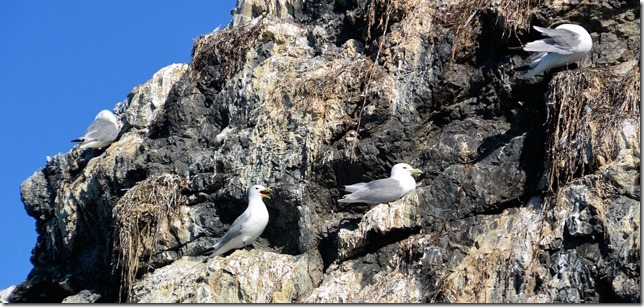
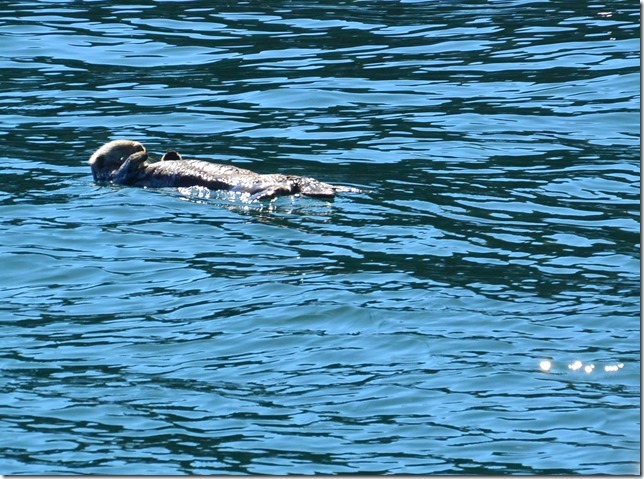
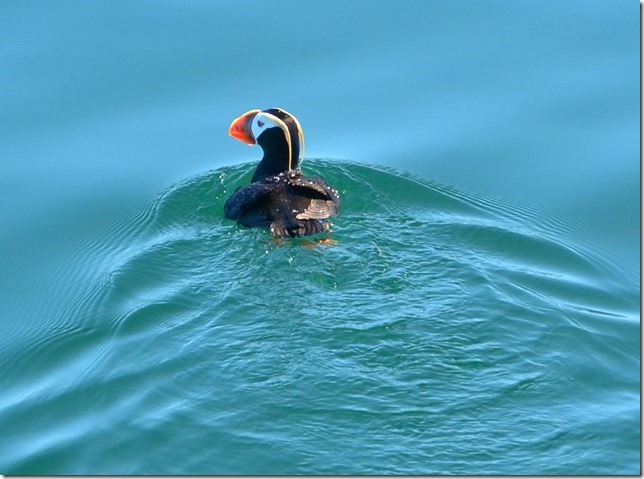
Later in the crossing, some fog moved in to spoil our view of the shoreline. But it lifted just as we reached Seldovia, and we got to see the town in some pleasant sunshine.
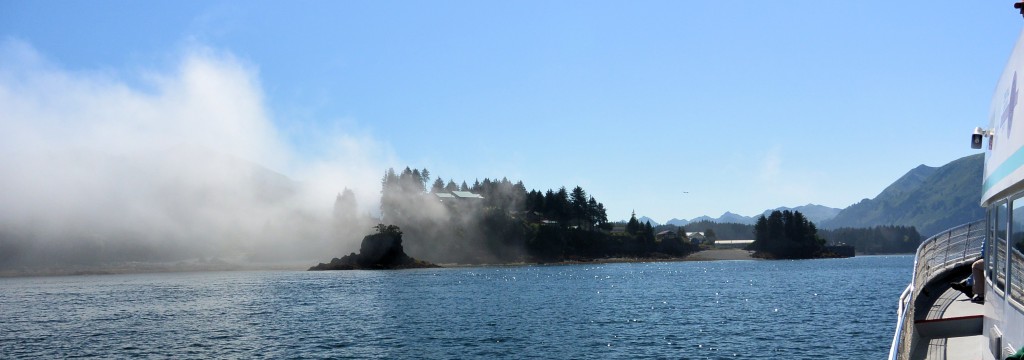
Seldovia has a “main” street about a block long, with some eateries and a few souvenirs. The residents live up from the main street, in a wide variety of housing, all kind of in a hippie-quaint mix.

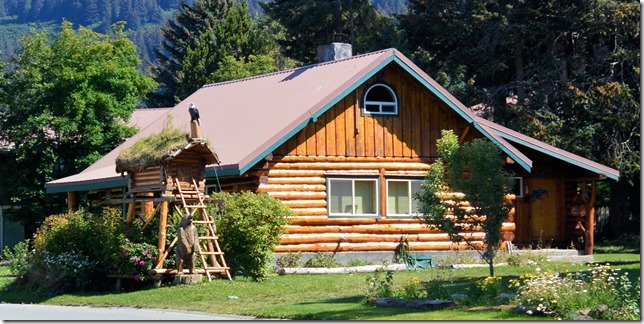
The bridge across the local stream east of town gives us yet another view of spawning salmon, this time very clear and very dense. A guy on the shore was having zero luck snag-fishing these critters.
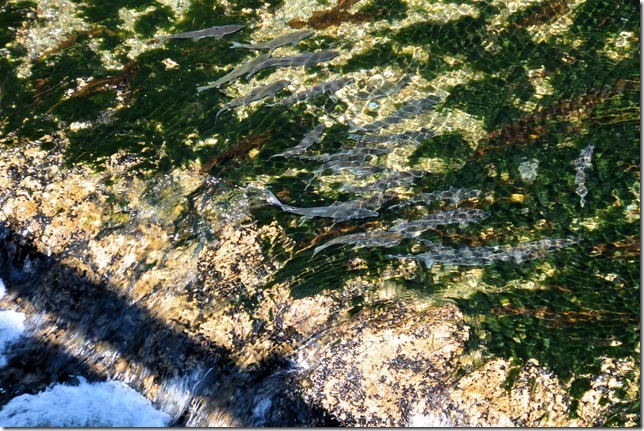
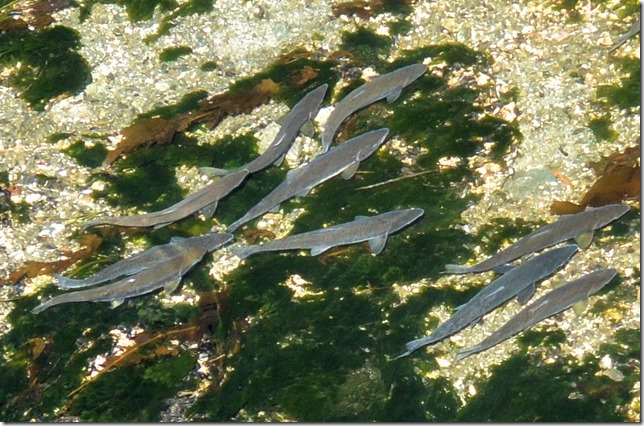
Some clever carvings, identified on the tour map, are all over the “downtown” area.
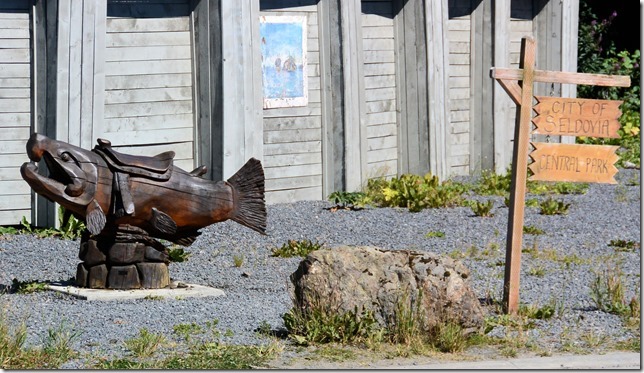
Up the hill, an old Russian Orthodox church is yet another reminder of the early history of Alaska.
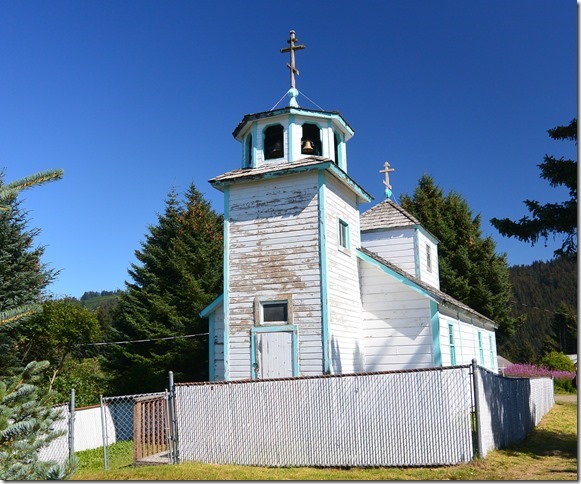
On the return trip, the fog set in with vigor, and we had little to see. Just before getting back to the spit, the skies cleared and we began sighting some distant humpback whale spouts. We spent about a half-hour watching and waiting, but the big beasts never got close enough to give us more than a fleeting glimpse of a fluke. It was fun trying though. And we knew they were there.

While traveling to/from the boat tour, we were presented with a dock-side example of the tidal differences. Same ramp, low tide on the left, high tide on the right. Quite a climb back up at low tide, like three flights of stairs.
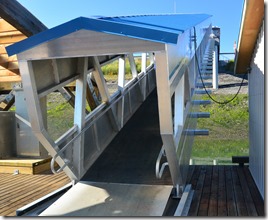
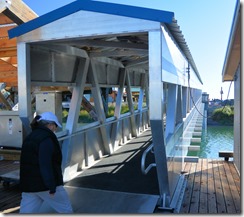
Side-trip: East-End Road and Fox River There’s a low-profile road that leaves town and wanders back up the northwestern shore of Kachemak Bay, called East-End Road. We decided to explore it a bit. Turns out, this road goes more than 20 miles back into the residential back country, with beautiful little homes and cabins tucked away on the hillsides. It’s easy to see why some folks really like living in the area, far away from the tourism (except us of course). We probably saw 15 cars or so in 3-4 hours. Kids walking in the middle of the road, farm lads holding onto their hats while ATV-ing over to a neighbor’s, ice-fields in the Kachemak Wilderness gleaming in the background.
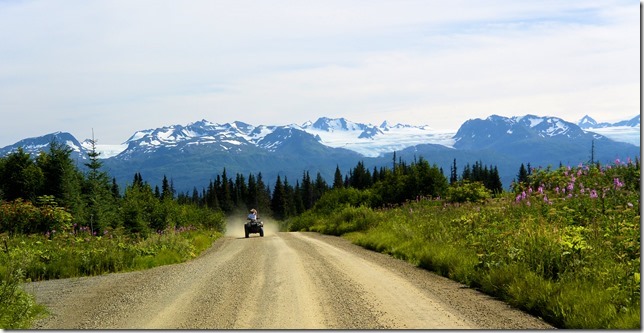
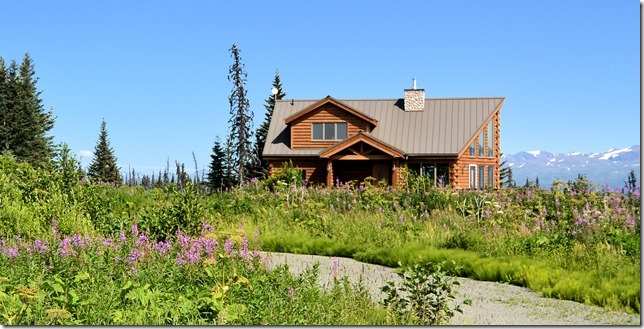
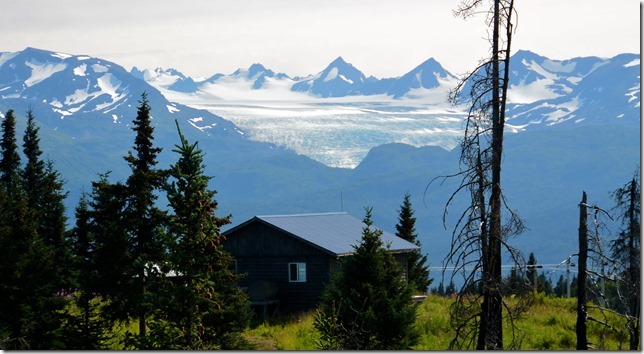
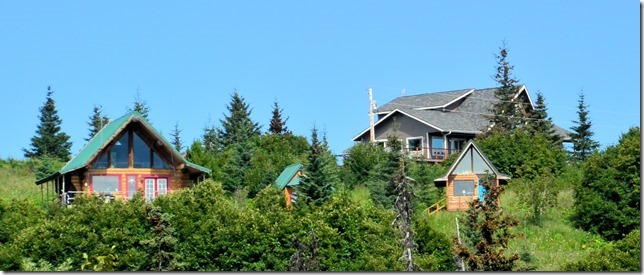
At the end of the road, more dirt roads continue, including one gnarly cliff-side rock-and-dust-fest that had Ralph in 4WD for a while. Here’s an example of the road “quality”. The logs were part of the road, which has since washed out about eight feet back from the guard rail. Most of the road is just wide enough for Ralph, which made for fun with the two cars we passed going the other way. Makes that soft “scritching” sound when the rear-view mirrors rub against each other.
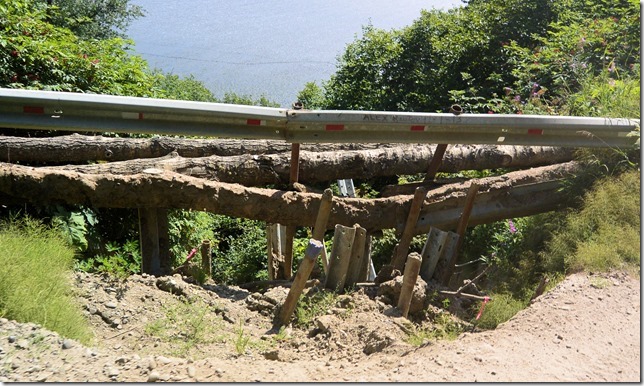
But it was worth the journey, with the last precipitous drop leading to an abandoned beach. Just us and a few horseback riders for miles of coastline.
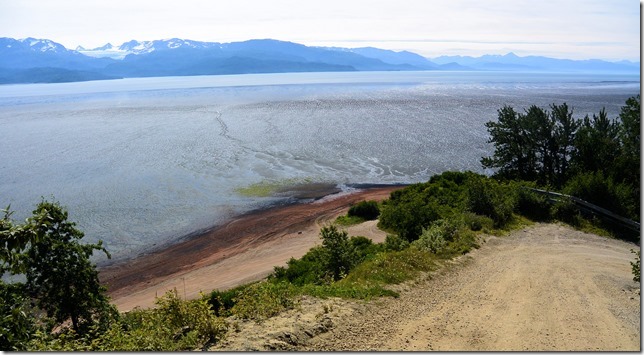
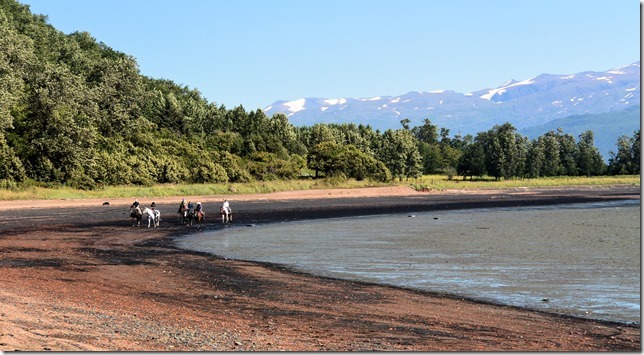
Side-trip: Save-U-More I’m only half-kidding about this being a side-trip. Over the months we’ve been traveling, supplies have always been an issue as we go through mostly small towns. In the more remote areas, it was very common to have to purchase “fresh” goods clearly past their “use-by” dates. Our diet/food requirements are particularly demanding, and really good natural and organic foods have been rare indeed. Thus it was with real delight that we discovered Save-U-More on a back street in Homer. This somewhat peculiar store has one of the broadest food selections we’ve seen since leaving the San Jose area’s markets. The organization was, shall we say, inventive. Many times we found similar or identical products on shelves several aisles apart. Some aisles go north-south, some aisles go east-west. No rhyme or reason to it. Seems to have grown incrementally over time. It was tough to find what we needed — but we always found it, and more. We spent an hour trekking up and down the dimly-lit aisles, with their incredible assortments of foods and brands, all stacked on cheap shelves set on bare concrete floors. Save-U-More is not wasting any money on décor. Yet another check-mark in the “+” column for Homer.
Homer also has some other niceties for us travelers – easy-access gas stations, public dump stations, a decent laundromat, a farmer’s market twice a week. And then there’s Tourist Central, the shops out on the Spit. Although they’re in some ways same-old, same-old tours and souvenirs, Homer has managed to keep things kind of cool in the appearance department, with the buildings casually staggered rather than apartment-house in-line. We had just as much fun here as in any of the other places.
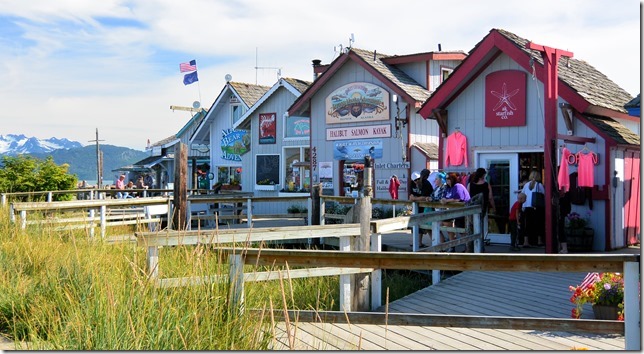
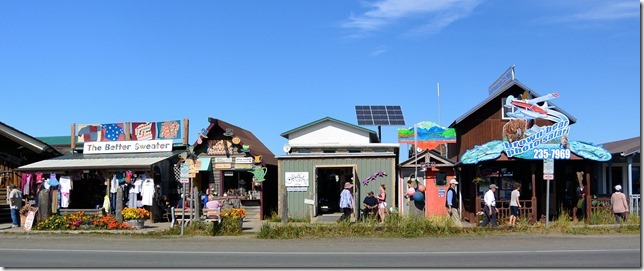
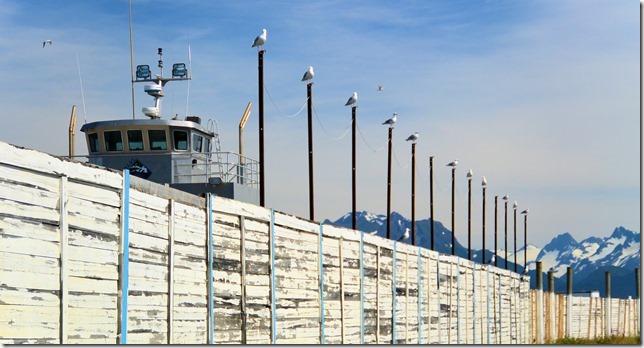 Did we miss some things? Oh definitely yes. A return trip would include a back-country ATV tour and a trip over to Halibut Cove, plus some more hiking across the Bay in the Park. But there are other places to visit before the weather turns.
Did we miss some things? Oh definitely yes. A return trip would include a back-country ATV tour and a trip over to Halibut Cove, plus some more hiking across the Bay in the Park. But there are other places to visit before the weather turns.
So, after nearly a week on the spit, it’s time to move on. Here we are on the western-most highway in North America (that’s connected), and most of our travel from now on will be moving in a homeward direction. Just a little over 3,000 miles to go….
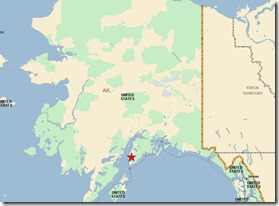 Miles driven (Howie): 6,004
Miles driven (Howie): 6,004- Miles driven (Ralph): 2,331
- Days traveling: 78
- Miles from home: 3,328

rita has sent me your travels and I send them on to my daughter who is on a cruise ship there. She won’t see what you see but maybe some interesting places. Notice you showed how pretty the fireweed flower is in the natural setting. When I was young the flowers meant so much when I could hike in the cascades. I enjoyed all I have seen. Hope you write a book with pictures.
Thanks, Sylvia. But y’know I barely have time to write the blog, let alone a book. Glad you enjoyed the posts.
Great Stories and Pics again and again..quite an inside you show about
everything in detail about the great State of Alaska..
waiting for more..
tony lem
Tony, I have to tell you what we see up here is only about 1% of all the things there are to see up here. And what I write about is only about 1% of what we see. This is a very very big place.